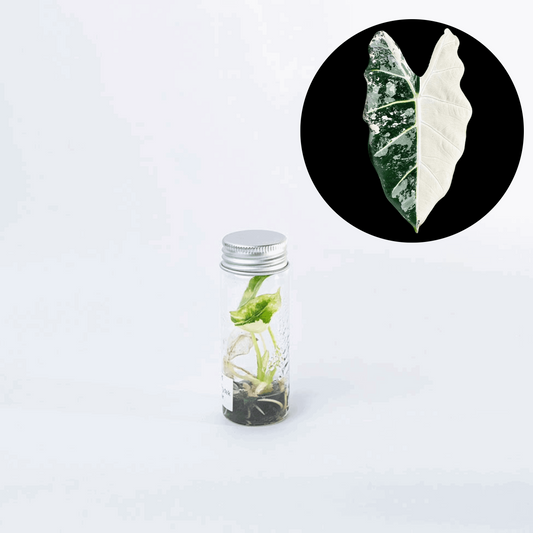Variegated Alocasia Plants
-
Variegated Alocasia Odora Batik Tissue Culture Plant
Vendor:Tropicflow's Indoor PlantsRegular price From $25.99 USDRegular priceUnit price per -
Variegated Alocasia Ninja Tissue Culture Plant
Vendor:Tropicflow's Indoor PlantsRegular price From $39.99 USDRegular priceUnit price per -
Variegated Alocasia Frydek Tissue Culture Plant
Vendor:Tropicflow's Indoor PlantsRegular price From $39.99 USDRegular priceUnit price per -
Variegated Alocasia Amazonica Polly Tissue Culture Plant
Vendor:Tropicflow's Indoor PlantsRegular price From $24.99 USDRegular priceUnit price per -
Variegated Alocasia Longiloba Tissue Culture Plant
Vendor:Tropicflow's Indoor PlantsRegular price From $29.99 USDRegular priceUnit price per -
Variegated Alocasia Gageana Aurea Tissue Culture Plant
Vendor:Tropicflow's Indoor PlantsRegular price From $12.99 USDRegular priceUnit price per -
Alocasia Bambino Tissue Culture Plant
Vendor:Tropicflow's Indoor PlantsRegular price From $24.99 USDRegular priceUnit price per
FAQs about the Alocasia Plant
How to Care for Alocasia
To care for an Alocasia plant, follow these guidelines:
- Light: Provide bright, indirect light. Avoid direct sunlight to prevent leaf burn.
- Water: Keep the soil consistently moist, but avoid waterlogging. Water when the top inch of soil is dry.
- Humidity: Alocasia plants thrive in high humidity. Use a humidifier or mist the leaves regularly.
- Temperature: Maintain a temperature between 60°F and 80°F (16°C to 27°C).
- Soil: Use well-draining, nutrient-rich soil.
- Fertilizer: Feed with a balanced liquid fertilizer every 2-4 weeks during the growing season (spring and summer).
How to Propagate Alocasia
To propagate Alocasia, follow these steps:
- Identify corms or offsets that have formed at the base of the plant.
- Carefully separate the corms from the main plant, ensuring some roots are attached.
- Plant the corms in well-draining soil, covering them lightly.
- Keep the soil moist and place the pot in a warm, humid location until new growth appears.
Can Alocasia Grow in Water?
Yes, Alocasia can grow in water temporarily. To do this:
- Place the plant's root system in a container of water, ensuring the roots are submerged but the base of the plant is above water.
- Change the water weekly to prevent stagnation.
- Add liquid fertilizer once a month for nutrients.
However, growing Alocasia in water long-term is not ideal. It's best to eventually transfer it back to soil.
How Often to Water Alocasia
Water an Alocasia plant when the top inch of soil is dry. During the growing season (spring and summer), it may need watering every 1-2 weeks. In the dormant season (fall and winter), reduce the frequency, ensuring the soil remains slightly moist.
How to Grow Alocasia Corms
To grow Alocasia corms:
- Place the corms in a moist paper towel and seal them in a plastic bag.
- Keep the bag in a warm, dark place until roots develop.
- Plant the corms in soil once roots are established, keeping the soil moist but not waterlogged.
Why Is My Alocasia Drooping?
Alocasia plants can droop due to:
- Underwatering or overwatering
- Low humidity levels
- Insufficient light
Ensure proper care by adjusting the watering schedule, maintaining humidity, and providing adequate light.
Do Alocasias Like to Be Root Bound?
Alocasias prefer some room to grow and do not thrive when root-bound. If you notice the plant's roots circling the pot, it's time to repot into a container 1-2 inches larger.
Do Alocasias Flower?
Yes, Alocasias can flower, but it is rare for them to do so indoors. The flowers are spathe-like and less showy than the foliage.
Are Alocasia Toxic to Cats?
Yes, Alocasia plants are toxic to cats. They contain insoluble calcium oxalate crystals that can cause severe irritation if ingested. Symptoms in cats may include drooling, vomiting, difficulty swallowing, and oral irritation. To keep your pet safe, it's best to place Alocasia plants out of reach or opt for non-toxic houseplants.
Is Alocasia Toxic to Dogs?
Yes, Alocasia plants are toxic to dogs. If ingested, they can cause symptoms such as oral irritation, excessive drooling, vomiting, and difficulty swallowing. It's essential to keep Alocasia plants away from pets and seek immediate veterinary attention if your dog ingests any part of the plant.







